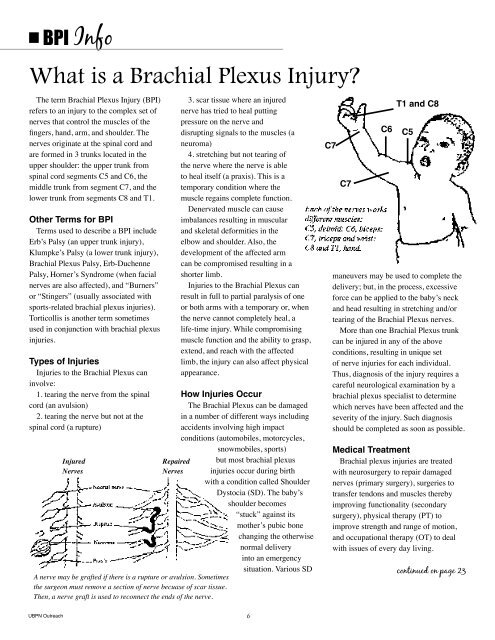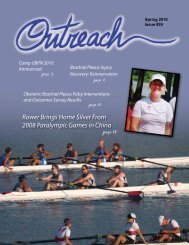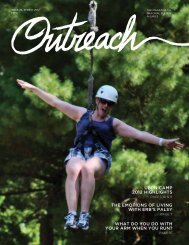Straight Talk Siblings
Spring 2007 Outreach (PDF) - United Brachial Plexus Network
Spring 2007 Outreach (PDF) - United Brachial Plexus Network
Create successful ePaper yourself
Turn your PDF publications into a flip-book with our unique Google optimized e-Paper software.
BPI Info<br />
What is a Brachial Plexus Injury?<br />
The term Brachial Plexus Injury (BPI)<br />
refers to an injury to the complex set of<br />
nerves that control the muscles of the<br />
fingers, hand, arm, and shoulder. The<br />
nerves originate at the spinal cord and<br />
are formed in 3 trunks located in the<br />
upper shoulder: the upper trunk from<br />
spinal cord segments C5 and C6, the<br />
middle trunk from segment C7, and the<br />
lower trunk from segments C8 and T1.<br />
Other Terms for BPI<br />
Terms used to describe a BPI include<br />
Erb’s Palsy (an upper trunk injury),<br />
Klumpke’s Palsy (a lower trunk injury),<br />
Brachial Plexus Palsy, Erb-Duchenne<br />
Palsy, Horner’s Syndrome (when facial<br />
nerves are also affected), and “Burners”<br />
or “Stingers” (usually associated with<br />
sports-related brachial plexus injuries).<br />
Torticollis is another term sometimes<br />
used in conjunction with brachial plexus<br />
injuries.<br />
Types of Injuries<br />
Injuries to the Brachial Plexus can<br />
involve:<br />
1. tearing the nerve from the spinal<br />
cord (an avulsion)<br />
2. tearing the nerve but not at the<br />
spinal cord (a rupture)<br />
Injured<br />
Nerves<br />
Repaired<br />
Nerves<br />
A nerve may be grafted if there is a rupture or avulsion. Sometimes<br />
the surgeon must remove a section of nerve becuase of scar tissue.<br />
Then, a nerve graft is used to reconnect the ends of the nerve.<br />
3. scar tissue where an injured<br />
nerve has tried to heal putting<br />
pressure on the nerve and<br />
disrupting signals to the muscles (a<br />
neuroma)<br />
4. stretching but not tearing of<br />
the nerve where the nerve is able<br />
to heal itself (a praxis). This is a<br />
temporary condition where the<br />
muscle regains complete function.<br />
Denervated muscle can cause<br />
imbalances resulting in muscular<br />
and skeletal deformities in the<br />
elbow and shoulder. Also, the<br />
development of the affected arm<br />
can be compromised resulting in a<br />
shorter limb.<br />
Injuries to the Brachial Plexus can<br />
result in full to partial paralysis of one<br />
or both arms with a temporary or, when<br />
the nerve cannot completely heal, a<br />
life-time injury. While compromising<br />
muscle function and the ability to grasp,<br />
extend, and reach with the affected<br />
limb, the injury can also affect physical<br />
appearance.<br />
How Injuries Occur<br />
The Brachial Plexus can be damaged<br />
in a number of different ways including<br />
accidents involving high impact<br />
conditions (automobiles, motorcycles,<br />
snowmobiles, sports)<br />
but most brachial plexus<br />
injuries occur during birth<br />
with a condition called Shoulder<br />
Dystocia (SD). The baby’s<br />
shoulder becomes<br />
“stuck” against its<br />
mother’s pubic bone<br />
changing the otherwise<br />
normal delivery<br />
into an emergency<br />
situation. Various SD<br />
C7<br />
C7<br />
C6<br />
T1 and C8<br />
C5<br />
maneuvers may be used to complete the<br />
delivery; but, in the process, excessive<br />
force can be applied to the baby’s neck<br />
and head resulting in stretching and/or<br />
tearing of the Brachial Plexus nerves.<br />
More than one Brachial Plexus trunk<br />
can be injured in any of the above<br />
conditions, resulting in unique set<br />
of nerve injuries for each individual.<br />
Thus, diagnosis of the injury requires a<br />
careful neurological examination by a<br />
brachial plexus specialist to determine<br />
which nerves have been affected and the<br />
severity of the injury. Such diagnosis<br />
should be completed as soon as possible.<br />
Medical Treatment<br />
Brachial plexus injuries are treated<br />
with neurosurgery to repair damaged<br />
nerves (primary surgery), surgeries to<br />
transfer tendons and muscles thereby<br />
improving functionality (secondary<br />
surgery), physical therapy (PT) to<br />
improve strength and range of motion,<br />
and occupational therapy (OT) to deal<br />
with issues of every day living.<br />
continued on page 23<br />
UBPN Outreach<br />
6





